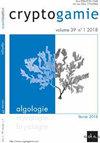The Scaled Chrysophyte Flora in Freshwater Ponds and Lakes from Newfoundland, Canada, and their Relationship to Environmental Variables
IF 1.5
4区 生物学
Q3 MARINE & FRESHWATER BIOLOGY
引用次数: 12
Abstract
Abstract The distributions of scaled chrysophytes in 22 waterbodies from the eastern portion of Newfoundland, Canada, are described relative to environmental gradients. A rich and diverse flora of scaled chrysophytes was recorded that included 47 species from six genera, Mallomonas (n = 29), Synura (n = 7), Neotessella (n = 1), Chrysosphaerella (n = 2), Spiniferomonas (n = 7) and Paraphysomonas (n = 1). Combined with previous works, 57 species of scaled chrysophytes are now known from Newfoundland. On average, 15 species were recorded from each site, and 34 of the taxa were found in more than 10% of the sites. The most widely distributed species were Mallomonas duerrschmidtiae, M. galeiformis, Synura echinulata, S. sphagnicola, and S. petersenii sensu lato, each found in over 75% of the study sites. Seven additional species were found in over 50% of the localities indicating the rich diversity of the flora. One site is of particular significance as it represents the type locality for three species, including Mallomonas newfoundlandicus sp. nov. described in this communication, and represents the northern-most site harboring the marker taxon, M. binocularis. Expanded descriptions of M. maculata and Spiniferomonas abei are given, and evidence is presented that Synura synuroidea represents two distinct species. Overall, the flora reflects habitats that are acidic, dilute and contain moderate to high concentrations of humic substances. Since many of the species are diagnostic bioindicators, these organisms would provide a valuable resource for future paleolimnological studies aimed at understanding impacts from environmental stressors on Newfoundland lakes.加拿大纽芬兰淡水池塘和湖泊中有鳞苔藓植物区系及其与环境变量的关系
摘要本文描述了加拿大纽芬兰东部22个水体中鳞虫的分布。有鳞苔藓植物区系丰富多样,包括Mallomonas (n = 29)、Synura (n = 7)、Neotessella (n = 1)、Chrysosphaerella (n = 2)、Spiniferomonas (n = 7)和Paraphysomonas (n = 1) 6属47种。结合前人的研究成果,目前纽芬兰有鳞苔藓植物共57种。平均每个站点记录到15种,超过10%的站点发现了34个分类群。分布最广的种是绿腹单胞菌(malomonas duerrschmidtiae)、galeiformis、刺青单胞菌(Synura echinulata)、绿腹单胞菌(S. sphagnicola)和彼得单胞菌(S. petersenii sensu lato),分布在75%以上的研究点。在超过50%的地点发现了7个额外的物种,表明植物区系的多样性丰富。其中一个地点具有特别的意义,因为它代表了三种物种的类型位置,包括本文描述的新芬兰Mallomonas sp. nov.,并且代表了最北端的标记分类群M. binocularis。扩充描述M. maculata和刺单胞菌abei,并提出证据,Synura synuroidea代表两个不同的物种。总的来说,植物区系反映了酸性、稀释和含有中等至高浓度腐殖质物质的生境。由于许多物种是诊断性生物指标,这些生物将为未来旨在了解环境压力对纽芬兰湖泊影响的古湖泊学研究提供宝贵的资源。
本文章由计算机程序翻译,如有差异,请以英文原文为准。
求助全文
约1分钟内获得全文
求助全文
来源期刊

Cryptogamie Algologie
生物-海洋与淡水生物学
CiteScore
2.60
自引率
7.70%
发文量
11
审稿时长
>12 weeks
期刊介绍:
Cryptogamie is a fast-track and peer-reviewed journal of international scope publishing in English only. It accepts original papers and review articles on the taxonomy, biology and ecology of all cryptogams. An issue of Cryptogamie may be devoted to a single topic, under the responsibility of guest editor(s). All articles published in Cryptogamie are compliant with the different nomenclatural codes. A copyright assignment will be signed by the authors before publication.
Cryptogamie, Algologie accepts articles on systematics as well as ecology and evolution of any kind of algae (including Cyanobacteria).
 求助内容:
求助内容: 应助结果提醒方式:
应助结果提醒方式:


